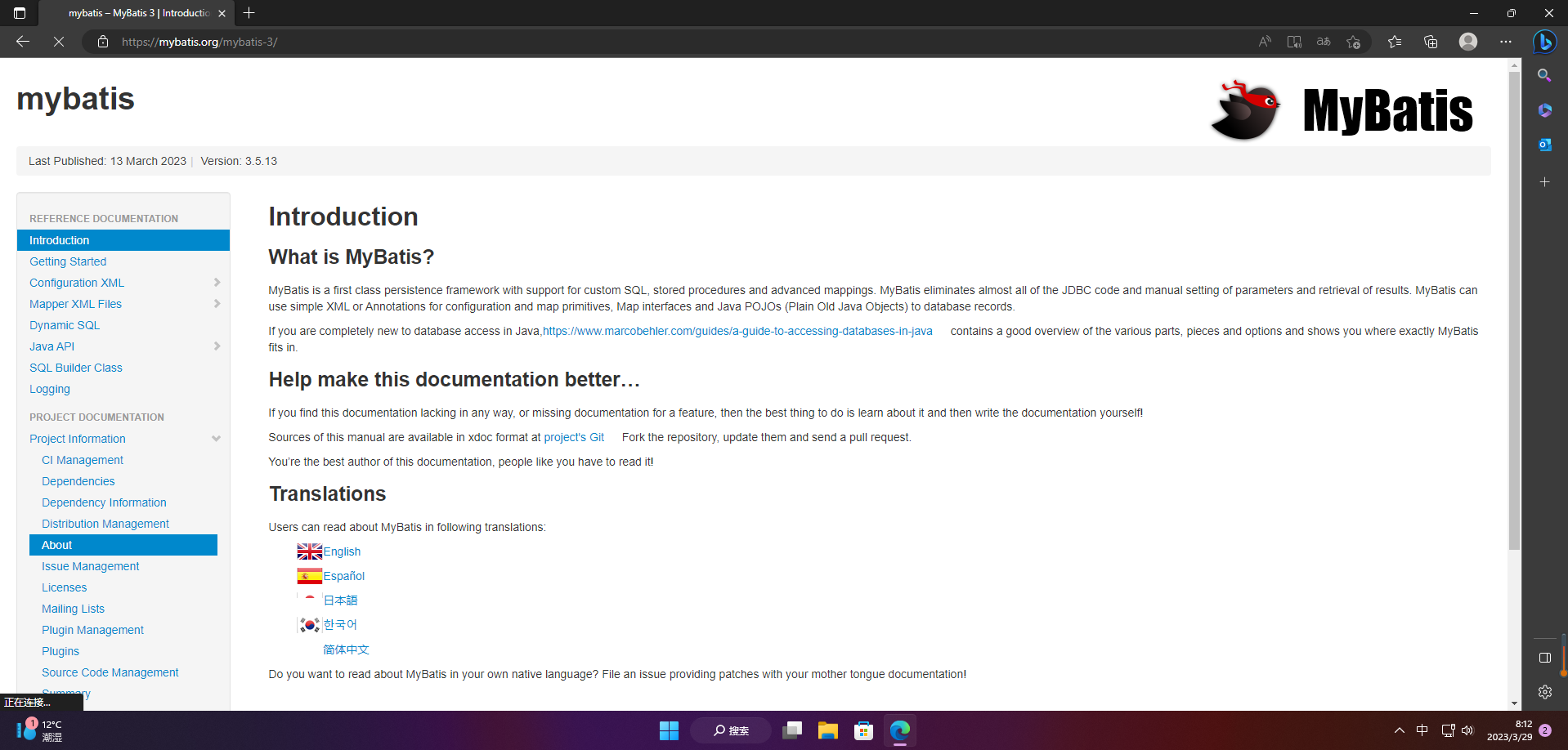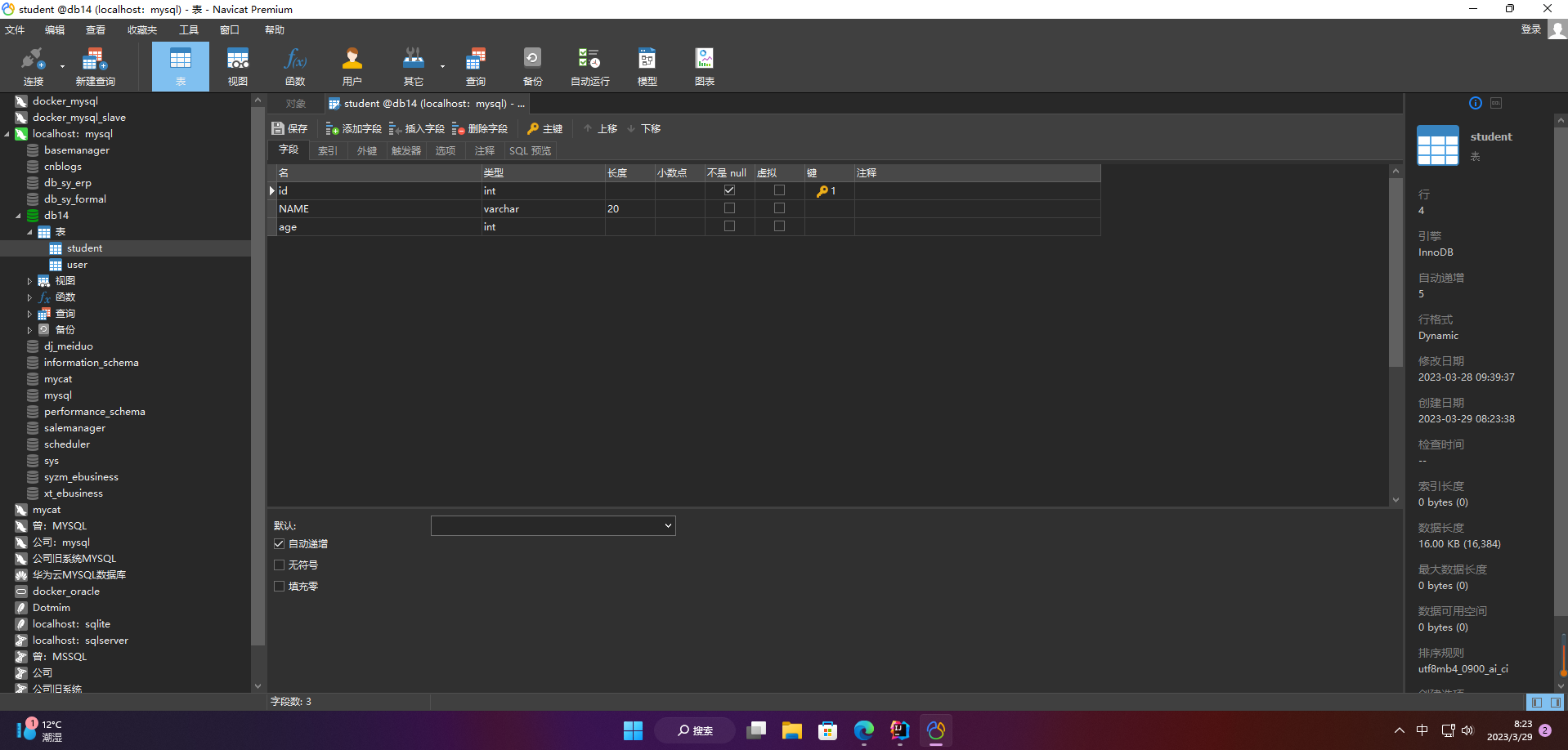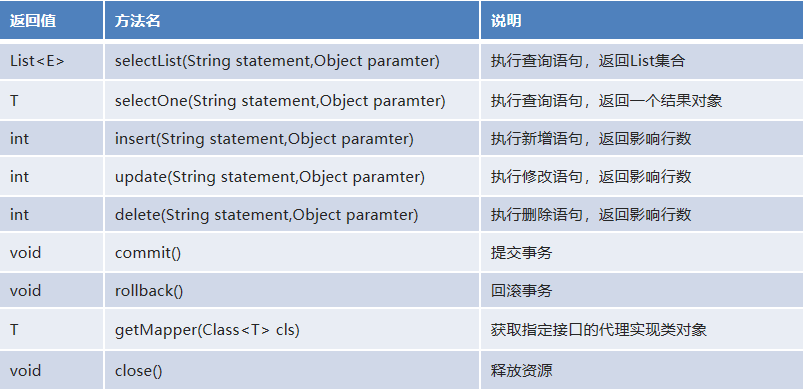文章目录
一.Mybatis快速入门
1.1 框架介绍
框架是指一种软件或编程语言的结构或基础,可以帮助开发人员快速构建复杂的应用程序。框架通常包括一系列的工具、库和规范,以便开发人员更容易地编写、测试和维护代码。框架可以帮助开发人员提高生产力、降低开发成本、提高代码质量和可维护性,同时也能够提供一些常用的功能和模块,使得开发者能够快速构建出具有一定规模和复杂度的应用程序。常见的框架包括Web开发框架、移动开发框架、游戏开发框架等。
1.2 ORM介绍
ORM(Object-Relational Mapping)是一种将对象和关系型数据库进行映射的技术,它可以将数据库操作转化为面向对象的操作,从而简化了开发人员的工作。ORM将数据库中的表映射为对象,将表中的行映射为对象的属性,将表中的列映射为对象的字段。通过ORM,开发人员只需要使用面向对象的方式操作数据库,无需关心底层数据库的细节。
ORM的优点包括:
- 简化了开发,提高了开发效率。
- 可以减少开发人员编写SQL语句的工作量。
- 使开发人员可以使用面向对象的方式操作数据库,降低了学习成本。
- 可以提高代码的可读性和可维护性。
- 可以自动创建数据库表和字段,减少了手动管理数据库的工作量。
ORM的缺点包括:
- 可能会影响系统的性能和效率。
- 需要额外的资源和工具的支持。
- ORM的映射可能不够灵活,无法满足复杂的查询需求。
- 对于复杂的数据模型,ORM可能会存在一定的限制。
ORM是一种非常有用的技术,可以简化开发人员的工作,提高开发效率,但同时也需要开发人员在使用时注意其性能和灵活性。
1.3 什么是Mybatis
Mybatis是一款基于Java语言的ORM框架,它的全称是MyBatis SQL Mapper Framework。Mybatis的主要功能是将Java对象和数据库中的记录进行映射,使得Java程序员可以使用面向对象的方式来操作数据库,同时也可以提高开发效率和代码的可维护性。Mybatis具有以下特点:
- 映射文件配置简单,易于维护。
- 支持动态SQL语句,可以根据不同的条件生成不同的SQL语句。
- 提供了多种查询方式,包括简单查询、复杂查询、分页查询等。
- 支持事务管理,可以保证数据的完整性和一致性。
- 可以与Spring等框架集成,提供更加便捷的开发方式。
- 性能优异,具有高并发、低延迟等特点。
MyBatis官网地址:http://www.mybatis.org/mybatis-3/

1.4 Mybatis的快速入门
MyBatis开发步骤:
- 添加MyBatis的jar包
- 创建Student数据表
- 编写Studentr实体类
- 编写映射文件StudentMapper.xml
- 编写核心文件MyBatisConfig.xml
- 编写测试类
1.4.1 环境搭建
1)导入MyBatis的jar包
- mysql-connector-j-8.0.32.jar
- mybatis-3.5.13.jar
- log4j-1.2.17.jar
- 创建student数据表

- 编写Student实体
package com.itheima.bean;
public class Student {
private Integer id;
private String name;
private Integer age;
public Student() {
}
public Student(Integer id, String name, Integer age) {
this.id = id;
this.name = name;
this.age = age;
}
public Integer getId() {
return id;
}
public void setId(Integer id) {
this.id = id;
}
public String getName() {
return name;
}
public void setName(String name) {
this.name = name;
}
public Integer getAge() {
return age;
}
public void setAge(Integer age) {
this.age = age;
}
@Override
public String toString() {
return "Student{" +
"id=" + id +
", name='" + name + '\'' +
", age=" + age +
'}';
}
}
4)编写jdbc.properties映射文件
driver=com.mysql.cj.jdbc.Driver
url=jdbc:mysql://127.0.0.1:3306/db1
username=root
password=123456
5)编写log4j.properties映射文件
# Global logging configuration
# ERROR WARN INFO DEBUG
log4j.rootLogger=DEBUG, stdout
# Console output...
log4j.appender.stdout=org.apache.log4j.ConsoleAppender
log4j.appender.stdout.layout=org.apache.log4j.PatternLayout
log4j.appender.stdout.layout.ConversionPattern=%5p [%t] - %m%n
6)编写MyBatisConfig.xml映射文件
<?xml version="1.0" encoding="UTF-8" ?>
<!--MyBatis的DTD约束-->
<!DOCTYPE configuration PUBLIC "-//mybatis.org//DTD Config 3.0//EN" "http://mybatis.org/dtd/mybatis-3-config.dtd">
<!--configuration 核心根标签-->
<configuration>
<!--引入数据库连接的配置文件-->
<properties resource="jdbc.properties"/>
<!--配置LOG4J-->
<settings>
<setting name="logImpl" value="log4j"/>
</settings>
<!--起别名-->
<typeAliases>
<typeAlias type="com.itheima.bean.Student" alias="student"/>
<!--<package name="com.itheima.bean"/>-->
</typeAliases>
<!--environments配置数据库环境,环境可以有多个。default属性指定使用的是哪个-->
<environments default="mysql">
<!--environment配置数据库环境 id属性唯一标识-->
<environment id="mysql">
<!-- transactionManager事务管理。 type属性,采用JDBC默认的事务-->
<transactionManager type="JDBC"></transactionManager>
<!-- dataSource数据源信息 type属性 连接池-->
<dataSource type="POOLED">
<!-- property获取数据库连接的配置信息 -->
<property name="driver" value="${driver}" />
<property name="url" value="${url}" />
<property name="username" value="${username}" />
<property name="password" value="${password}" />
</dataSource>
</environment>
</environments>
<!-- mappers引入映射配置文件 -->
<mappers>
<!-- mapper 引入指定的映射配置文件 resource属性指定映射配置文件的名称 -->
<mapper resource="StudentMapper.xml"/>
</mappers>
</configuration>
7)编写StudentMapper.xml映射文件
<?xml version="1.0" encoding="UTF-8" ?>
<!--MyBatis的DTD约束-->
<!DOCTYPE mapper
PUBLIC "-//mybatis.org//DTD Mapper 3.0//EN"
"http://mybatis.org/dtd/mybatis-3-mapper.dtd">
<!--
mapper:核心根标签
namespace属性:名称空间
-->
<mapper namespace="StudentMapper">
<!--
select:查询功能的标签
id属性:唯一标识
resultType属性:指定结果映射对象类型
parameterType属性:指定参数映射对象类型
-->
<select id="selectAll" resultType="student">
SELECT * FROM student
</select>
<select id="selectById" resultType="student" parameterType="int">
SELECT * FROM student WHERE id = #{id}
</select>
<insert id="insert" parameterType="student">
INSERT INTO student VALUES (#{id},#{name},#{age})
</insert>
<update id="update" parameterType="student">
UPDATE student SET name = #{name},age = #{age} WHERE id = #{id}
</update>
<delete id="delete" parameterType="int">
DELETE FROM student WHERE id = #{id}
</delete>
</mapper>
1.4.2 StudentMapper搭建
package com.itheima.service;
import com.itheima.bean.Student;
import java.util.List;
/*
业务层接口
*/
public interface StudentService {
//查询全部
public abstract List<Student> selectAll();
//根据id查询
public abstract Student selectById(Integer id);
//新增数据
public abstract Integer insert(Student stu);
//修改数据
public abstract Integer update(Student stu);
//删除数据
public abstract Integer delete(Integer id);
}
package com.itheima.mapper.impl;
import com.itheima.bean.Student;
import com.itheima.mapper.StudentMapper;
import org.apache.ibatis.io.Resources;
import org.apache.ibatis.session.SqlSession;
import org.apache.ibatis.session.SqlSessionFactory;
import org.apache.ibatis.session.SqlSessionFactoryBuilder;
import java.io.IOException;
import java.io.InputStream;
import java.util.List;
/*
持久层实现类
*/
public class StudentMapperImpl implements StudentMapper {
/*
查询全部
*/
@Override
public List<Student> selectAll() {
List<Student> list = null;
SqlSession sqlSession = null;
InputStream is = null;
try{
//1.加载核心配置文件
is = Resources.getResourceAsStream("MyBatisConfig.xml");
//2.获取SqlSession工厂对象
SqlSessionFactory sqlSessionFactory = new SqlSessionFactoryBuilder().build(is);
//3.通过工厂对象获取SqlSession对象
sqlSession = sqlSessionFactory.openSession(true);
//4.执行映射配置文件中的sql语句,并接收结果
list = sqlSession.selectList("StudentMapper.selectAll");
} catch (Exception e) {
e.printStackTrace();
} finally {
//5.释放资源
if(sqlSession != null) {
sqlSession.close();
}
if(is != null) {
try {
is.close();
} catch (IOException e) {
e.printStackTrace();
}
}
}
//6.返回结果
return list;
}
/*
根据id查询
*/
@Override
public Student selectById(Integer id) {
Student stu = null;
SqlSession sqlSession = null;
InputStream is = null;
try{
//1.加载核心配置文件
is = Resources.getResourceAsStream("MyBatisConfig.xml");
//2.获取SqlSession工厂对象
SqlSessionFactory sqlSessionFactory = new SqlSessionFactoryBuilder().build(is);
//3.通过工厂对象获取SqlSession对象
sqlSession = sqlSessionFactory.openSession(true);
//4.执行映射配置文件中的sql语句,并接收结果
stu = sqlSession.selectOne("StudentMapper.selectById",id);
} catch (Exception e) {
e.printStackTrace();
} finally {
//5.释放资源
if(sqlSession != null) {
sqlSession.close();
}
if(is != null) {
try {
is.close();
} catch (IOException e) {
e.printStackTrace();
}
}
}
//6.返回结果
return stu;
}
/*
新增功能
*/
@Override
public Integer insert(Student stu) {
Integer result = null;
SqlSession sqlSession = null;
InputStream is = null;
try{
//1.加载核心配置文件
is = Resources.getResourceAsStream("MyBatisConfig.xml");
//2.获取SqlSession工厂对象
SqlSessionFactory sqlSessionFactory = new SqlSessionFactoryBuilder().build(is);
//3.通过工厂对象获取SqlSession对象
sqlSession = sqlSessionFactory.openSession(true);
//4.执行映射配置文件中的sql语句,并接收结果
result = sqlSession.insert("StudentMapper.insert",stu);
} catch (Exception e) {
e.printStackTrace();
} finally {
//5.释放资源
if(sqlSession != null) {
sqlSession.close();
}
if(is != null) {
try {
is.close();
} catch (IOException e) {
e.printStackTrace();
}
}
}
//6.返回结果
return result;
}
/*
修改功能
*/
@Override
public Integer update(Student stu) {
Integer result = null;
SqlSession sqlSession = null;
InputStream is = null;
try{
//1.加载核心配置文件
is = Resources.getResourceAsStream("MyBatisConfig.xml");
//2.获取SqlSession工厂对象
SqlSessionFactory sqlSessionFactory = new SqlSessionFactoryBuilder().build(is);
//3.通过工厂对象获取SqlSession对象
sqlSession = sqlSessionFactory.openSession(true);
//4.执行映射配置文件中的sql语句,并接收结果
result = sqlSession.update("StudentMapper.update",stu);
} catch (Exception e) {
e.printStackTrace();
} finally {
//5.释放资源
if(sqlSession != null) {
sqlSession.close();
}
if(is != null) {
try {
is.close();
} catch (IOException e) {
e.printStackTrace();
}
}
}
//6.返回结果
return result;
}
/*
删除功能
*/
@Override
public Integer delete(Integer id) {
Integer result = null;
SqlSession sqlSession = null;
InputStream is = null;
try{
//1.加载核心配置文件
is = Resources.getResourceAsStream("MyBatisConfig.xml");
//2.获取SqlSession工厂对象
SqlSessionFactory sqlSessionFactory = new SqlSessionFactoryBuilder().build(is);
//3.通过工厂对象获取SqlSession对象
sqlSession = sqlSessionFactory.openSession(true);
//4.执行映射配置文件中的sql语句,并接收结果
result = sqlSession.delete("StudentMapper.delete",id);
} catch (Exception e) {
e.printStackTrace();
} finally {
//5.释放资源
if(sqlSession != null) {
sqlSession.close();
}
if(is != null) {
try {
is.close();
} catch (IOException e) {
e.printStackTrace();
}
}
}
//6.返回结果
return result;
}
}
1.4.3 StudentService搭建
package com.itheima.service;
import com.itheima.bean.Student;
import java.util.List;
/*
业务层接口
*/
public interface StudentService {
//查询全部
public abstract List<Student> selectAll();
//根据id查询
public abstract Student selectById(Integer id);
//新增数据
public abstract Integer insert(Student stu);
//修改数据
public abstract Integer update(Student stu);
//删除数据
public abstract Integer delete(Integer id);
}
package com.itheima.service.impl;
import com.itheima.bean.Student;
import com.itheima.mapper.StudentMapper;
import com.itheima.mapper.impl.StudentMapperImpl;
import com.itheima.service.StudentService;
import java.util.List;
/*
业务层实现类
*/
public class StudentServiceImpl implements StudentService {
//创建持久层对象
private StudentMapper mapper = new StudentMapperImpl();
@Override
public List<Student> selectAll() {
return mapper.selectAll();
}
@Override
public Student selectById(Integer id) {
return mapper.selectById(id);
}
@Override
public Integer insert(Student stu) {
return mapper.insert(stu);
}
@Override
public Integer update(Student stu) {
return mapper.update(stu);
}
@Override
public Integer delete(Integer id) {
return mapper.delete(id);
}
}
1.4.4 StudentController搭建
package com.itheima.controller;
import com.itheima.bean.Student;
import com.itheima.service.StudentService;
import com.itheima.service.impl.StudentServiceImpl;
import java.util.List;
/*
控制层测试类
*/
public class StudentController {
//创建业务层对象
private StudentService service = new StudentServiceImpl();
//查询全部功能测试
public void selectAll() {
List<Student> students = service.selectAll();
for (Student stu : students) {
System.out.println(stu);
}
}
//根据id查询功能测试
public void selectById() {
Student stu = service.selectById(3);
System.out.println(stu);
}
//新增功能测试
public void insert() {
Student stu = new Student(4,"赵六",26);
Integer result = service.insert(stu);
System.out.println(result);
}
//修改功能测试
public void update() {
Student stu = new Student(4,"赵六",16);
Integer result = service.update(stu);
System.out.println(result);
}
//删除功能测试
public void delete() {
Integer result = service.delete(4);
System.out.println(result);
}
}
1.4.5 运行
package com.itheima;
import com.itheima.controller.StudentController;
public class Main {
public static void main(String[] args) {
StudentController stu=new StudentController();
stu.selectAll();
}
}

二、MyBatis的相关api
1.1 Resources
-
org.apache.ibatis.io.Resources:加载资源的工具类。
-
核心方法

1.2 构建器SqlSessionFactoryBuilder
-
org.apache.ibatis.session.SqlSessionFactoryBuilder:获取 SqlSessionFactory 工厂对象的功能类
-
核心方法

-
通过加载mybatis的核心文件的输入流的形式构建一个SqlSessionFactory对象
String resource = "org/mybatis/builder/mybatis-config.xml";
InputStream inputStream = Resources.getResourceAsStream(resource);
SqlSessionFactoryBuilder builder = new SqlSessionFactoryBuilder();
SqlSessionFactory factory = builder.build(inputStream);
其中, Resources 工具类,这个类在 org.apache.ibatis.io 包中。Resources 类帮助你从类路径下、文件系统或一个 web URL 中加载资源文件。
1.3 工厂对象SqlSessionFactory
-
org.apache.ibatis.session.SqlSessionFactory:获取 SqlSession 构建者对象的工厂接口。
-
核心api

1.4 SqlSession会话对象
-
org.apache.ibatis.session.SqlSession:构建者对象接口。用于执行 SQL、管理事务、接口代理。
-
核心api

SqlSession 实例在 MyBatis 中是非常强大的一个类。在这里你会看到所有执行语句、提交或回滚事务和获取映射器实例的方法。